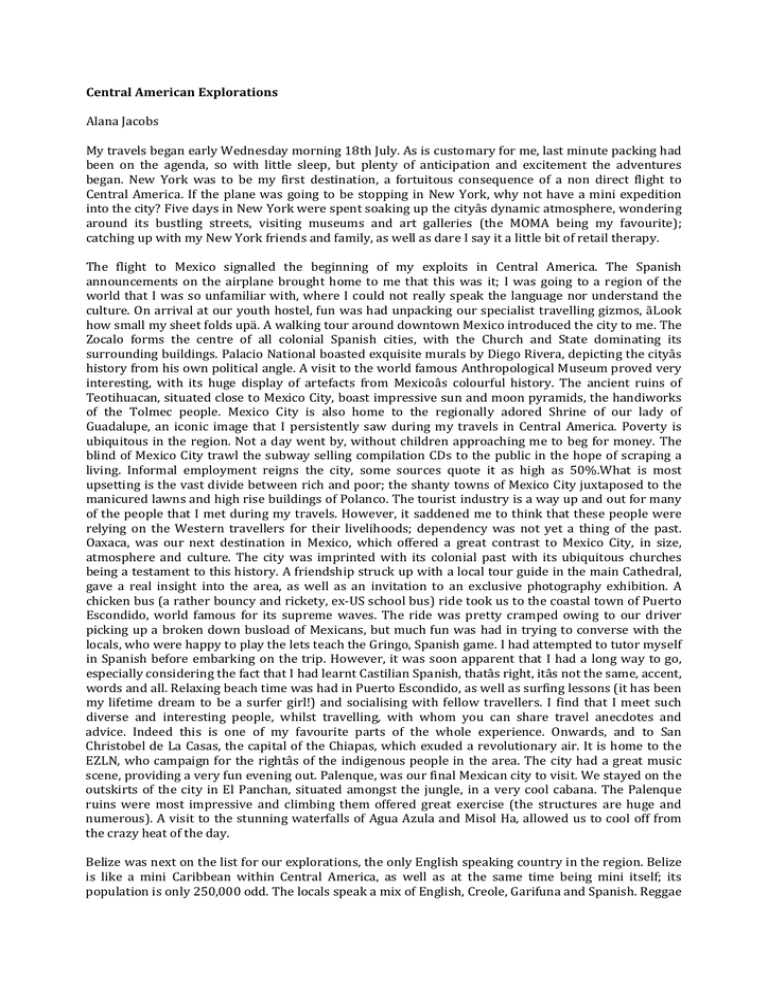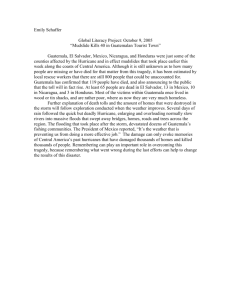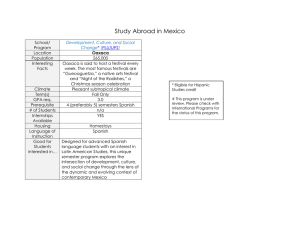Central American Explorations Alana Jacobs My travels began early Wednesday morning 18th July. As is customary for me, last minute packing had
advertisement

Central American Explorations Alana Jacobs My travels began early Wednesday morning 18th July. As is customary for me, last minute packing had been on the agenda, so with little sleep, but plenty of anticipation and excitement the adventures began. New York was to be my first destination, a fortuitous consequence of a non direct flight to Central America. If the plane was going to be stopping in New York, why not have a mini expedition into the city? Five days in New York were spent soaking up the cityâs dynamic atmosphere, wondering around its bustling streets, visiting museums and art galleries (the MOMA being my favourite); catching up with my New York friends and family, as well as dare I say it a little bit of retail therapy. The flight to Mexico signalled the beginning of my exploits in Central America. The Spanish announcements on the airplane brought home to me that this was it; I was going to a region of the world that I was so unfamiliar with, where I could not really speak the language nor understand the culture. On arrival at our youth hostel, fun was had unpacking our specialist travelling gizmos, ãLook how small my sheet folds upä. A walking tour around downtown Mexico introduced the city to me. The Zocalo forms the centre of all colonial Spanish cities, with the Church and State dominating its surrounding buildings. Palacio National boasted exquisite murals by Diego Rivera, depicting the cityâs history from his own political angle. A visit to the world famous Anthropological Museum proved very interesting, with its huge display of artefacts from Mexicoâs colourful history. The ancient ruins of Teotihuacan, situated close to Mexico City, boast impressive sun and moon pyramids, the handiworks of the Tolmec people. Mexico City is also home to the regionally adored Shrine of our lady of Guadalupe, an iconic image that I persistently saw during my travels in Central America. Poverty is ubiquitous in the region. Not a day went by, without children approaching me to beg for money. The blind of Mexico City trawl the subway selling compilation CDs to the public in the hope of scraping a living. Informal employment reigns the city, some sources quote it as high as 50%.What is most upsetting is the vast divide between rich and poor; the shanty towns of Mexico City juxtaposed to the manicured lawns and high rise buildings of Polanco. The tourist industry is a way up and out for many of the people that I met during my travels. However, it saddened me to think that these people were relying on the Western travellers for their livelihoods; dependency was not yet a thing of the past. Oaxaca, was our next destination in Mexico, which offered a great contrast to Mexico City, in size, atmosphere and culture. The city was imprinted with its colonial past with its ubiquitous churches being a testament to this history. A friendship struck up with a local tour guide in the main Cathedral, gave a real insight into the area, as well as an invitation to an exclusive photography exhibition. A chicken bus (a rather bouncy and rickety, ex‐US school bus) ride took us to the coastal town of Puerto Escondido, world famous for its supreme waves. The ride was pretty cramped owing to our driver picking up a broken down busload of Mexicans, but much fun was had in trying to converse with the locals, who were happy to play the lets teach the Gringo, Spanish game. I had attempted to tutor myself in Spanish before embarking on the trip. However, it was soon apparent that I had a long way to go, especially considering the fact that I had learnt Castilian Spanish, thatâs right, itâs not the same, accent, words and all. Relaxing beach time was had in Puerto Escondido, as well as surfing lessons (it has been my lifetime dream to be a surfer girl!) and socialising with fellow travellers. I find that I meet such diverse and interesting people, whilst travelling, with whom you can share travel anecdotes and advice. Indeed this is one of my favourite parts of the whole experience. Onwards, and to San Christobel de La Casas, the capital of the Chiapas, which exuded a revolutionary air. It is home to the EZLN, who campaign for the rightâs of the indigenous people in the area. The city had a great music scene, providing a very fun evening out. Palenque, was our final Mexican city to visit. We stayed on the outskirts of the city in El Panchan, situated amongst the jungle, in a very cool cabana. The Palenque ruins were most impressive and climbing them offered great exercise (the structures are huge and numerous). A visit to the stunning waterfalls of Agua Azula and Misol Ha, allowed us to cool off from the crazy heat of the day. Belize was next on the list for our explorations, the only English speaking country in the region. Belize is like a mini Caribbean within Central America, as well as at the same time being mini itself; its population is only 250,000 odd. The locals speak a mix of English, Creole, Garifuna and Spanish. Reggae fills the air and BBQ is the thing! I spent most of my time on Caye Caulker, a caye so small that it only had three roads named according to their location, front, middle and back! To get into the spirit of things, I had my hair corn‐rowed and partyied it up at a local karaoke bar, a favourite pastime of Belizians. A fishing trip of ours ended up being very successful; we caught snapper and barracuda, which we later ate for dinner, as well as snorkelling through shark and ray alley. Cave tubing and zip lining, provided much fun as well as exposing to me the jungle and countryside of Belize. On the mainland, I visited Belmopan and Belize City, which looked like they had not changed since the 1960s; all shop signs were still hand painted! Locals freely spoke of the corruption within the Government, a consequence of Belize receiving independence before it was ready. Although a country riddled with problems, the locals still had much pride in their homeland. This was apparent throughout Central America and really touched me, as I think its something that is often lacking in Britain. We left Belize, to embark on a difficult and long journey to the Bay Islands in Honduras. To reach the Bay Islands it would take us two days of chicken busses, boats, coaches, corrupt taxi drivers and two lots of boarder crossings. These islands, although being incredibly popular, are unbearably hard to arrive at. The Bay Islands offer some of the best diving in the world, with their reefs being a continuation of the Belize reefs (the second largest barrier reef in the world!). Utila was our chosen destination, owing to its infamy amongst backpackers for great vibes and economy of prices. Utila fulfilled its promises of offering a unique environment; time seemed to slow right down with chill defining the island. A little gem of the island is the jade seahorse, an amazing little cafŽ, whose owner had decorated in a multitude of glass sculptures rendering it really quite fantastical. My stay on Utila lasted for five days, in which I completed my PADI advanced diving qualification (thatâs right, I can dive to 30m, yay!). The diving was awesome; I saw fantastic fish, coral and even a moray eel and a sea turtle! Unfortunately my night dive was cancelled, owing to stormy weather conditions, with all boats being brought into harbour (there was even talk of a hiatus in boats heading back to the mainland). Instances such as this are a reminder to me of natureâs omnipotence; man has not conquered all! Once again, a rather protracted journey via La Ceiba and San Pedro Sula (may I add that if in doubt of a towns name in Central America, San Pedro is always a sure bet) led us to Copan Ruinas. A quaint little town near the Honduran‐Guatemalan boarder, that is home to what it claims to in its name, some superb Mayan ruins. Cobbled streets, cute hostels, tuk‐tuks and a great bird sanctuary made it a great town to visit. Over the border once again and into Guatemala, the supposed Îmost dangerousâ country on my travels. I found often whilst travelling that the actual danger is far less than the perceived danger; I did not ever really feel like I was in an unsafe place. Nevertheless we acted sensibly, avoiding wandering around alone and at night. Antigua formed our base in Guatemala. Antigua does colonial city like no other, beautifully cobbled grid‐patterned streets, colourfully painted houses, and traditionally dressed locals. The city is located in the valley of three volcanoes, which makes for spectacular views. Day trips were taken to neighbouring villages, to gain a deeper appreciation of the area. What struck me about the people of Central America was their love of life. I could not help but think that perhaps as Westerners we had got it wrong. Life is not about the material, but about enjoying life itself. Coffee plantation tours seem to be the thing to visit, which is probably not surprising considering its one of the big industries of Guatemala. Climbing Volcan Pacaya probably was the highlight of my stay in Guatemala. The volcano is active and therefore a pretty awesome sight to behold, I actually saw molten lava, bubbling and flowing before me. The climb was demanding, our rather adventurous guide took us an interesting route (right over the molten lava, my shoes were melting!) and I fell owing to an unstable rock, resulting in blood everywhere and some rather ugly scars on my legs. But I still loved it! We travelled into the highlands of Guatemala and to Lago de Atitlan, which was once described by Aldous Huxley as Îthe most beautiful lake in the worldâ, and he was not far off. The lake is situated within a caldera (a collapsed volcano cone), and glistens proudly in the shadows of the surrounding topography. We stayed in the travellersâ town of San Pedro la Laguna, which we used as a base to visit the vibrant little towns dotted around the lake, reached by very fun water taxis. Unfortunately, whilst there I became ill, but this is almost an expected experience when backpacking. Central America is a deeply devout Catholic region, a consequence of the regionsâ colonial past. However, it was not a Catholicism of which I was used to, but a chimera of Mayan intermixed with Christianity. No where was this more exemplified than in the lake‐side market town of Santiago Atitlan, home to Maximon. The deity is a combination of Mayan gods and biblical Judas; a wooden figure, dressed colourfully and smoking a cigar, whose favourite gifts are cigarettes and alcohol. It all was slightly bizarre to me, but an interesting sight to behold nonetheless. As already touched upon, large amounts of time were spent travelling from place to place on the trip. Roads are not of the best quality and most have to weave themselves through the dramatic topography of the region. Bus time although frustrating at points, offered opportunities for planning, reflection and fun times with my travel buddies. Our flight was out of Mexico City, so a 24 hour bus ride from Guatemala was on the cards. My final few days in Mexico City, allowed me to see sites that I had not had the time to visit first time around; Frida Kahloâs house, the Xochimilco (Mexicoâs little Venice!), markets, modern art museum and more. My trip was fantastic. I achieved my objective; to visit the region and gain an understanding and appreciation of the area and its culture. Central America is beautiful and offers rewarding experiences to its travellers. The people of the area exude friendliness, warmth, love of their country and life itself. The scenery is breathtaking, and the culture dynamic. Memories of this incredible voyage will stay with me Iâm sure for a long time into the future.




